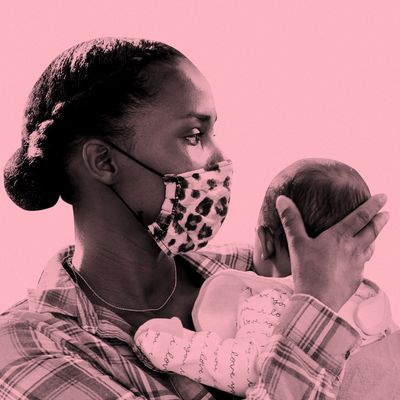
I gave birth to my son in July, just as the Delta variant was starting to freak people out. At first I wasn’t wildly concerned, at least for my immediate circle. I got vaccinated while I was pregnant, and so did just about everyone else I knew. (Also, I was worried about other things, like whether I would ever sleep again.)
But then I started hearing about breakthrough cases. And higher hospitalization numbers for kids. And confusing information — was this variant making people sicker? Or was it just more contagious? Or both? And how common were these breakthrough infections actually? Did I mention I was tired?
To get better answers — or at least figure out how to assess COVID risks for babies and toddlers, which will soon be the only age groups unable to get vaccinated — I spoke to several experts about how to stay safe without losing my mind. Here’s what they told me.
Does the Delta variant make young children sicker than other COVID strains?
In short, no, says Emily Oster, an economist who studies health economics at Brown and is the author of the best-selling ParentData books. (I recommend her newsletter, which parses emerging research on pregnancy and parenting, COVID-related and otherwise.) “There’s this narrative that Delta is really dangerous for kids, much more dangerous than previous variants. But that’s not true in the numbers,” she says. “There’s nothing in the data that would suggest that the rate of hospitalization for kids has gone up in any meaningful way.”
Still, more kids are getting sick, and that’s why the numbers are confusing: The Delta variant is more transmissible than previous strains, so it has infected more people, including more children. But — and this is an important distinction — Delta does not appear to be making those children sicker than earlier forms of the virus. “The rates of infections in kids mirror their proportion in the population,” says Dr. Vijay Prasad, a pediatrician with Tribeca Pediatrics.
The reason you may have heard about pediatric ICUs filling up is that those facilities are generally small (pediatric beds make up less than 2 percent of beds in the intensive-care system in the U.S., as of a 2010 survey). “The pediatric health-care system is not designed for a flood of kids who need inpatient care, so capacity was limited,” Dr. Prasad explains. This became a serious problem in places like Texas that were suddenly dealing with a bunch of sick children at the peak of the Delta wave. But the fact remains that the Delta variant is no more likely to put your kid in the hospital than any other form of COVID, and the risk of severe COVID in children remains much lower than it is for other age groups.
What about babies, though?
It’s true that very small babies are more at risk for most things germ-related, because their immune systems are so new and undeveloped. But they are also less likely to come in contact with germs, because they’re not walking around touching stuff. And once babies are a few months old, they become part of the lowest-risk group for contracting COVID, says Dr. Allison Messina, the chief of the Division of Infectious Disease at Johns Hopkins All Children’s Hospital. (That lowest risk group is zero- to 4-year-olds, followed by 5- to 11-year-olds.)
“Throughout the pandemic, the most critically ill kids we see are unvaccinated, older teenagers with COVID,” she adds. “And that’s even more sad, because those are kids that could have been vaccinated, but they were not.”
I was vaccinated while I was pregnant. How much does that actually protect my baby?
If you’re vaccinated while pregnant, your baby gets antibodies through the placenta. Those antibodies are protective, but they do wear off after a few months, says Dr. Messina.
(Note that this is not the same case for you, the vaccinated person. The vaccines teach your T-cells, which are part of your immune system, to produce antibodies. So even after those active antibodies decay, your T-cells “remember” how to make them, and can do so quickly to fight off the infection before it makes you very sick. Your baby will not have this ability until they get vaccinated themselves.)
It might sound scary that your baby will lose immunity after a few months. But remember that those early months are when babies have the weakest immune systems, so your antibodies will tide them over until they’re older and stronger, says Dr. Messina.
What about breastfeeding? Can a baby get protection from antibodies in breast milk?
Some. But it’s hard to say exactly how much, and the research is ongoing. “In one study that tested breast milk six weeks after vaccination, they found high antibody levels,” says Dr. Prasad. “It’s not as good as getting the actual vaccine while the baby is in the womb, which gives direct access to antibodies. But it is something.”
What are some ways to protect kids who are too little to wear masks?
The one time I brought my baby to a grocery store, I draped a muslin blanket over his head to try to shield him from potential germs. (He was asleep and didn’t care.) Was this ridiculous?
Actually no, says Dr. Danielle Zerr, the chief of infectious disease and virology at Seattle Children’s Hospital. “If you put a barrier between your baby and other people — whether it’s a draped blanket or a carrier that has a windshield or cover — you’re keeping some large droplets off the baby and out of the air that the baby is breathing.” This isn’t as effective as a vaccine or a mask (which, of course, aren’t recommended or safe for kids under the age of 2). But it’s not a total waste of effort either. “If you’re in a crowded scenario that you can’t avoid, those strategies make sense to me.”
That said, taking your kid to the grocery store is not as dicey as you might think. “The chance that your infant acquires COVID at the grocery store is really, really small,” says Oster. “If somebody with COVID got up in their face and coughed on them, then yeah, okay, maybe. But it’s a pretty well-ventilated space, and you’re probably not that close to other people. COVID is not lurking around, waiting to jump on your baby.”
What if you have a baby as well as another young, unvaccinated kid who could get them sick?
This is tricky since toddlers and young kids do tend to bring home a lot of germs from day care or preschool. But if it’s any consolation, those germs aren’t likely to be COVID, says Oster. “In most of Europe, they’ve had day cares and preschools open for much of the pandemic, and they do not mask kids under 5. And those kids still had a much lower risk of contracting COVID than the older kids, even the older kids wearing masks.” Still, stringent hand-washing is always a good idea.
How else do we keep our very young kids safe from the Delta variant?
Remember the basics. “An exposure is defined as within six feet for a cumulative period of 15 minutes over 24 hours,” says Dr. Prasad. So don’t worry so much about that sniffling, unmasked man who brushed past your stroller at CVS; instead, focus on avoiding situations where your child is close to a potentially infected person for a significant period of time.
Above all, you want to ensure (whenever possible) that anyone who comes in contact with your baby is vaccinated. Sure, there’s a very small chance that they could have a breakthrough infection without knowing it. But even if that happens, a vaccinated person is still less likely to be very contagious, even with the Delta variant. “More research on breakthrough infections is needed,” says Oster. “But I think what we’re going to learn is vaccinated people are really unlikely to spread COVID aggressively to other people if they’re asymptomatic.”
And finally, your own mental health is part of keeping your kids safe, too. “There are considerations beyond COVID that are worth remembering,” says Oster. So create boundaries that work for you and remember that you can always adjust them as you go along.


